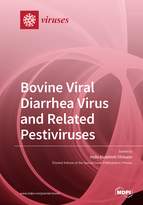Bovine Viral Diarrhea Virus and Related Pestiviruses
A special issue of Viruses (ISSN 1999-4915). This special issue belongs to the section "Animal Viruses".
Deadline for manuscript submissions: closed (31 May 2020) | Viewed by 69759
Special Issue Editor
2. School of Chemistry and Molecular Biosciences, The University of Queensland, St. Lucia, QLD 4072, Australia
3. School of Veterinary Medicine, The University of Queensland, Gatton Campus, Gatton, QLD 4343, Australia
Interests: infectious diseases pathobiology; viral persistence; flaviviruses; transplacental virus infections; co-infections; viral zoonoses; arbo-viruses; influenza viruses
Special Issues, Collections and Topics in MDPI journals
Special Issue Information
Dear Colleagues,
The genus Pestivirus, encompassing small positive-strand RNA viruses in the family Flaviviridae, comprises four viruses of very significant economic impact to the cattle, swine and sheep industries: bovine viral diarrhea virus (BVDV)-1 and -2, classical swine fever virus (CSFV) and border disease virus (BDV). In addition, a number of novel viruses have been detected in wild and domestic animals by isolation and/or virome studies, which appear to be related to the pestiviruses and may qualify as new pestivirus species. In this Issue, we would like to focus on studies aiming at establishing the pathogenesis of the pestiviruses and candidate pestiviruses, including transplacental infections and virus persistence. Research studies can also be focused on the epidemiology, development and evaluation of diagnostic assays, virus discovery, transmission pathways, virulence, clinical aspects and vaccines.
Dr. Helle Bielefeldt-Ohmann
Guest Editor
Manuscript Submission Information
Manuscripts should be submitted online at www.mdpi.com by registering and logging in to this website. Once you are registered, click here to go to the submission form. Manuscripts can be submitted until the deadline. All submissions that pass pre-check are peer-reviewed. Accepted papers will be published continuously in the journal (as soon as accepted) and will be listed together on the special issue website. Research articles, review articles as well as short communications are invited. For planned papers, a title and short abstract (about 100 words) can be sent to the Editorial Office for announcement on this website.
Submitted manuscripts should not have been published previously, nor be under consideration for publication elsewhere (except conference proceedings papers). All manuscripts are thoroughly refereed through a single-blind peer-review process. A guide for authors and other relevant information for submission of manuscripts is available on the Instructions for Authors page. Viruses is an international peer-reviewed open access monthly journal published by MDPI.
Please visit the Instructions for Authors page before submitting a manuscript. The Article Processing Charge (APC) for publication in this open access journal is 2600 CHF (Swiss Francs). Submitted papers should be well formatted and use good English. Authors may use MDPI's English editing service prior to publication or during author revisions.
Keywords
- pestivirus
- bovine viral diarrhea virus
- mucosal disease
- classical swine fever virus
- border disease virus
- pathogenesis
- viral persistence
- transplacental infection







